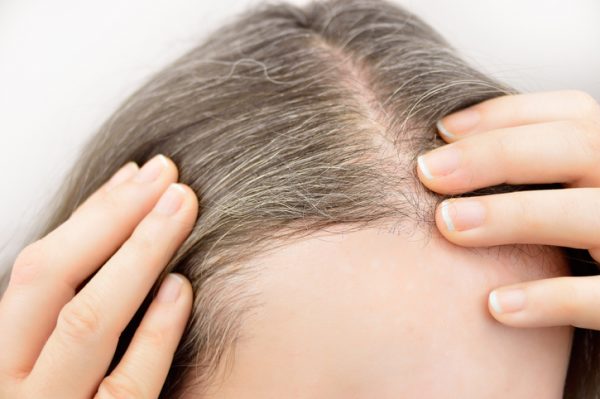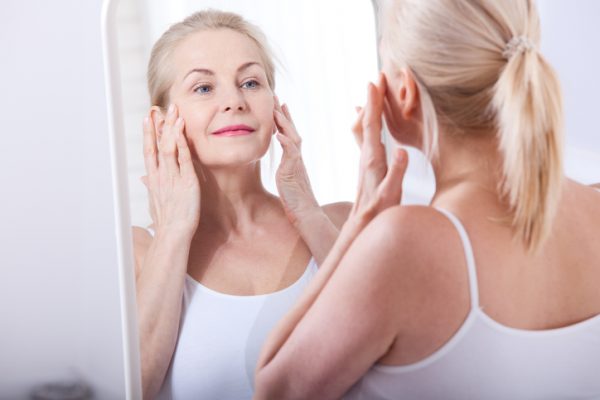Aging Hair: 5 Common Concerns & How to Solve Them

Your hair, just like your skin, is susceptible to natural aging processes. As you get older, you’ll gradually begin noticing signs of aging hair, like significant differences in the color, texture, thickness, health and manageability of your hair.
If your hair has lost a little thickness and vibrancy over the years, don’t worry. Try these anti-aging hair tricks to add volume, boost shine, restore color and strengthen fine hair at any age.
How to Thicken Aging Hair
The Problem: Fine, Thinning Hair
If your hair seems less full than it used to, you’re definitely not imagining things. Thinning hair is all a part of the hair aging process. Dermatologists report that in our late 30s and 40s, individual hairs will start to grow in finer. Luckily, there are short- and long-term fixes to help add volume and thickness to aging hair.
Short-Term Fix:
Work a pea-size amount of Viviscal Hair Thickening Serum into damp hair, then blow dry or air dry and style as usual. This body-boosting treatment makes fine and aging hair look thicker and fuller.
Another solution? The right haircut, of course! For women with straight hair, stylists recommend a blunt cut to make fine aging hair look thicker. For curls, add layers to help them look bouncy and full.
Long-Term Help:
Hairstylists swear by Viviscal Hair Growth Supplements to promote existing hair growth from within. In fact, Harper’s Bazaar recently called them one of the best hair growth vitamins for longer, stronger hair!*
Viviscal is proven to nourish hair follicles with B vitamins like biotin and niacin, plus iron, vitamin C and the proprietary marine complex AminoMar™ to help support the growth of thicker, fuller hair in 3-6 months.
Remember that as with all hair supplements, consistency is key. Try to take the full dose of two tablets every day, and avoid skipping days or doses as that can delay your results.*
 How to Stop Aging Hair Loss
How to Stop Aging Hair Loss

The Problem: Age-Related Hair Loss
Half of all women will experience some kind of hair loss by the time they hit age 50, according to the North American Hair Research Society. There are four stages that hair goes through in the hair growth cycle—a growing phase (anagen), a regression phase (catagen), a resting phase (telogen) and a shedding phase (exogen). As you get older, your hair spends more time in the resting phase of the cycle, which means you’re shedding hair faster than it’s growing back.
Unlike male hair loss, which usually starts as a receding hairline and thinning crown, female hair loss occurs as a gradual thinning all over your scalp. In fact, many dermatologists advise that women often don’t immediately notice their hair coming out in the shower or in your brush. But then, over time, more of your scalp becomes visible.
Some of us may have drawn the short genetic straw when it comes to hair loss. In that case, age-related hair loss may be unavoidable.
For other women, a number of other factors could be taking a toll on hair growth. For some, the hormonal fluctuations of menopause or nutritional deficiencies may be the culprits. Other very common causes of women’s hair loss are an underactive thyroid and stress.
Short-Term Fix:
Hair products also can affect how thinning, aging hair looks. The wrong shampoo and conditioner can make aging hair loss more apparent by weighing hair down or over-drying aging hair that’s already more fragile and prone to damage. Switch to lightweight, nourishing shampoo and conditioner formulas designed to make thinning hair look thicker, such as Thickening Shampoo and Conditioner. As an added bonus, these products are fortified with hair-strengthening nutrients to improve the condition of your hair on the outside.
Long-Term Help:
One long-term drug treatment is over-the-counter minoxidil, which stimulates hair regrowth. However, once you begin taking minoxidil, you need to commit to taking it long-term, because when you stop taking it, your hair regrowth will reverse.
If you believe your hormones have become imbalanced with age, it’s best to see your primary care doctor, gynecologist or an endocrinologist to get to the bottom of the issue.
But for others, a good diet and stress relief tactics will make a huge difference in the health of our hair. Improved nutrition may even help balance our thyroid and hormone levels. Hair loss experts recommend:
Reduce stress by relaxing, getting enough sleep, and turning off TVs and all other devices with screens a couple of hours before bed. If you watch TV in the evening, stay away from news, or more violent or disturbing, shows after 6 p.m. to ease into a stress-free mindset before bed.
Eat a varied diet full of lean proteins, fruits, vegetables, whole grains, and healthy fats.
Take a supplement that is rich in biotin, such as Viviscal Hair Growth Supplements. Biotin won’t increase the number of hairs on your head but it can make your existing hair thicker, according to a 2012 study published in the Journal of Clinical and Aesthetic Dermatology1. Dermatologists believe that biotin helps build up fatty acids and protein in the hair shaft to make hair thicker and stronger. This is why many dermatologists recommend daily biotin supplements to their patients.*
How to Boost Shine & Softness

The Problem: Dry, Lackluster Hair
As you age, production of oil glands on your scalp may slow down. That’s why aging hair may feel drier and look less glossy.
Short-Term Fix:
Work a drop of hair oil or shine-enhancing serum into your palms, then run it through damp hair beginning at the ends, as these are usually driest. Avoid your roots as adding oil at the scalp could make hair look greasy. You can do this on dry hair too on days when you’re not shampooing.
Long-Term Help:
Apply a deep-conditioning coconut oil mask to hair once a week to boost shine. Rub a scoop of coconut oil between your hands to warm it up and then spread it on the bottom half of dry hair. Leave the oil on your hair for at least one hour, and then shampoo it out with a mild shampoo like Viviscal Thickening Shampoo. Coconut oil not only conditions, but experts believe it may even help to decrease protein loss from hair strands.
Changing your diet can also boost shine and softness in aging hair. The best addition to your diet? Eat more fatty fish such as salmon or tuna, which are rich in omega-3 fatty acids, substances shown to give hair more shine, thickness and luster. Tip: If you don’t like fish, you can get more omegas in your diet from plant-based sources such as flaxseeds or walnuts.
Better yet, try Viviscal Hair Growth Supplements, a complete, clinically proven hair supplement for women. It not only has marine extracts and biotin, but also vitamin C, zinc, iron and niacin to nourish follicles and promote existing hair growth.*
How to Restore Radiant Color

The Problem: Graying Dull Hair
You see those pesky grays reappear between colorings, and your natural hair color fades over time.
Short-Term Fix:
If you’re just starting to see gray hairs, it’s okay to pluck them. Despite that old myth, it won’t make the grays grow back any faster. Often, if we pluck a gray hair and then notice more coming in, we just assume there’s a correlation. In fact, It’s fine to pluck an occasional gray, but beware of waging war on your tresses — too much plucking can weaken hair, making it more susceptible to split ends and breakage.
If you have a significant amount of grays, you can use a temporary root touch-up spray such as Toppik™ Hair Filler Volumizing Micro-Fibers to cover roots between hair appointments.
Long-Term Help:
Let’s face it, everyone’s aging hair eventually will go gray. But using permanent hair color helps minimize the time between return trips to the salon. And if you’re dyeing your hair at home, choose an at-home dye that is specifically designed to cover grays.
Or avoid the repeated colorist visits altogether and allow your hair to go gray naturally. To enhance your silver locks, shampoo hair once a week with a purple shampoo. This type of shampoo will help increase shine and prevent brassy tones. You can find a good purple shampoo at most salons.
How to Strengthen Aging Hair
The Problem: Fragile, Damaged Hair
Because aging hair grows finer over time, strands can be more fragile and more prone to breakage while styling or brushing. This could lead to damaged-looking hair, split ends and less volume overall.
Short-Term Fix:
Go to your stylist every 6-8 weeks for regular trims. This will help remove those frayed, split ends, and will keep your hair looking its healthiest and thickest. For an even quicker, more temporary fix for split ends, apply a styling cream formulated for breakage to your ends daily.
You can also add volume to aging hair strands with a fortifying serum such as Viviscal Hair Thickening Serum. Its lightweight formula has keratin, biotin, zinc and a proprietary complex called Ana:Tel™, to make hair look thicker and fuller. Apply the leave-in elixir to damp or dry hair daily and style as usual.
Long-Term Help:
One of the biggest culprits behind damaged, breaking hair is heat! Cut back on your use of blow-dryers, straighteners and curling irons. If you must use heat tools, try a lower temperature setting.
Use Thickening Shampoo and Conditioner, which are formulated with ingredients to make aging hair look thicker and therefore easier to style. These products also help add strength to the outside of strands making aging hair less prone to breakage.
For extra damage prevention, avoid brushing or combing wet hair, which is when it’s extra fragile and prone to breaking. Avoid bleaching your hair, which can actually make strands more porous and inhibit their ability to retain moisture, making them extra susceptible to breakage. Bleaching actually raises hairs’ outer cuticles, allowing bleach to fully penetrate the hair strand. And dermatologists have found that repeated bleaching may actually permanently raise cuticle scales, allowing rapid and continuous loss of moisture. Yikes!
Taking a hair-strengthening supplement like Viviscal Hair Growth Supplements twice daily fortifies hair from the inside out by supplying hair follicles with the vitamins and minerals needed for existing healthy hair growth.*
While we can’t completely escape the signs of aging, these tips and tricks will help to disguise some of the most noticeable signs of aging hair.
†Existing hair growth
1Glynis A. A Double-blind, Placebo-controlled Study Evaluating the Efficacy of an Oral Supplement in Women with Self-perceived Thinning Hair. J Clin Aesthet Dermatol. 2012;5(11):28-34.
